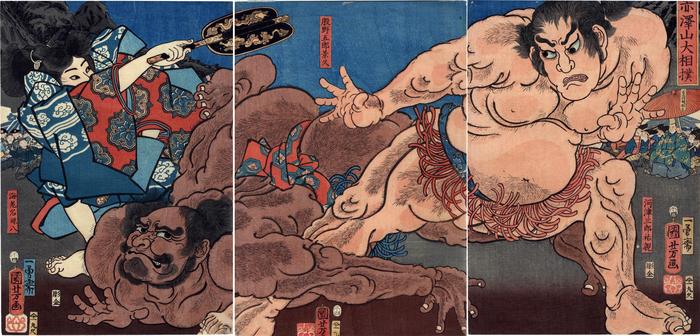Utagawa Kuniyoshi (歌川国芳) (artist 11/15/1797 – 03/05/1861)
The Sumō Bout at Akazawa Mountain (Akazawa ōzumō - 赤澤山大相撲) with Kawazo Saburō Sukeyasu (河津三郎祐親) on the right and Matano Gorō Kagehisa (股野五郎景久) on the left
04/1858
30 in x 14 in (Overall dimensions) Japanese color woodblock print
Signed: Ichiyūsai Kuniyoshi ga
一勇斎国芳画
Artist's seal: kiri
Publisher: Maruya Kyūshirō
(Marks 298 - seal 21-126)
Carver: Hori Kane
Date seal: 4/1858
Nationaal Museum van Wereldculturen (Rijksmuseum Volkenkunde, Leiden) via Ritsumeikan University - preliminary sketch The most famous sumo wrestling match between Kawazo Saburō Sukeyasu (right) and Matano Gorō Kagehisa refereed by Ebina Genpachi at Akazawayama Mountain in 1176. In the background can be seen the first Kamakura shogun Minamoto no Yoritomo and his entourage. The match gave rise to a new maneuver called the “Kawazu hold [the kawazu-gake 河津掛].”
One of Kuniyoshi’s great triptychs; much sought after and rare. The original preparatory drawing for this triptych is in the Rijksmuseum voor Volkenkunde, Leiden. See Heroes and Ghosts, Hotei publishing, 1998, no.156, p.148.
****
The sumō bout at Akazawa Mountain led to the Soga brothers revenge tale.
****
There is another copy of this triptych in the National Museum of Ethnology in Leiden and the preparatory drawing for it.
****
In an early kabuki production of the encounter on Mt. Akazawa the poet Hezutsu Tōsaku wrote of "The kabuki actor Ōtani Hiroji [I] 大谷広治 (1696–1747), three generations before the current bearer of that name, had a very dark complexion and was nick-named “black Jitchō” (黒十町). He excelled in the delivery of his lines. Although he could not read a word, he related historical events and used ancient phrases without sounding as if he were repeating what others had read out for him. When he spoke of the wrestling match of Matano [Kagehisa] 股野景久 (?–1183), he raised his voice with the lines, “And lo! He was thrown three inches deep into the black earth of Mt. Akazawa 赤沢,” and then, in a lower and softer voice, he continued, “Ah! He felt as if he had lived his life in vain!”56 Listeners were deeply moved and shouted their approval." Translated by Gerald Groemer.
****
Illustrated:
1) In Drawings by Utagawa Kuniyoshi in the National Museum of Ethnology, Leiden, published by SDU, The Hague, 1988. (Both the preparatory drawing and the triptych are illustrated.)
2) In color in 歌川国芳展: 生誕200年記念 Utagawa Kuniyoshi: Exhibition to Commemorate the 200th Anniversary of his birth, 1996, #87, p. 85.
3) In color in Kuniyoshi by Jūzō Suzuki, Heibonsha Limited, Publishers, 1992, no. 176.
4) In color in 原色浮世絵大百科事典 (Genshoku Ukiyoe Daihyakka Jiten), vol. 3, p. 82, #336.
5) In color in Kuniyoshi: Japanese master of imagined worlds by Iwakiri Yuriko with Amy Reigle Newland, Hotei Publishing, 2013, p. 66, pl. 40.
Iwakiri and Newland wrote:
"Before Minamoto no Yoritomo raises his army for Izu, military lords from the region assemble to participate in a hunt... A sumo match is also planned as entertainment at a banquet on Mount Akazawa once the hunt is concluded. Matano Kagehisa reigns triumphant when he defeats twenty-one people in a row, but the runner-up Kawazu no Saburō then hurls him to the ground using a hooking backward counter throw known as 'Kawazu-gake', a move that has survived to the present day. Kawazu was later killed by an arrow from a retainer of Kudō Suketsune. Kawazu's orphaned sons were placed in the care of the Soga family and they are the players in the vendetta tale of the Soga brothers.
In this powerful composition one can almost hear the trembling of the ground inside the ring as Matano is knocked down by his opponent. Even the motioning by the referee (gyōji) Ebina, as he hurls himself aside, creates a sense of frenetic movement. The figure of Yoritomo is visible in the right background. Although the date seal (horse 4) indicates a publication date of 1858, it is thought that the work was designed slightly earlier in around the mid-1850s. The National Museum of Ethnology, Leiden, houses the preliminary drawing (sōkō)."
6) In black and white in Sumo and the Woodblock Print Masters by Lawrence Bickford, fig. 108, p. 144.
7) In color in Ukiyo-e Masterpieces in European Collection 5: Victoria and Albert Museum II, Kodansha, 1989, #44.
warrior prints (musha-e - 武者絵) (genre)
Maruya Kyūshirō (丸屋久四郎) (publisher)
sumō (相撲) (genre)
Soga brothers (曾我兄弟) (genre)
